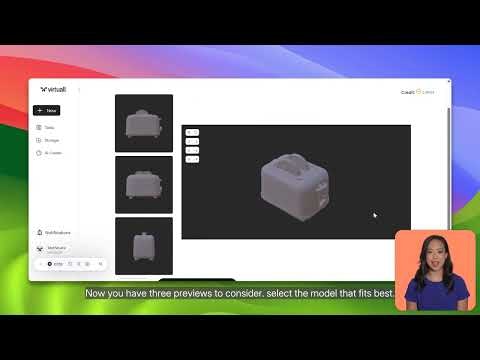Table of Contents
Overview
Currently, AI-driven 3D model generation is rapidly advancing, enabling the creation of professional 3D assets from text prompts or images within minutes. Major platforms including Meshy AI, Hunyuan3D 2.0, Spline, and Tripo AI are transforming traditional manual 3D modeling workflows. These tools have been adopted across medical, architectural, gaming, and educational sectors, demonstrating processing time reductions of over 90%.
Key Features
Based on verified actual capabilities, the accurate characteristics include:
- Multi-Input AI 3D Model Generation: Creates 3D models from text, single images, or multiple images, with Meshy AI providing 8 options within 60 seconds
- Iterative Refinement System: Enables refinement to high-resolution versions after generating 4 preview images, with LumaLabs requiring 5-20 minutes for detailed models
- Professional Collaboration: Spline supports multiple simultaneous users with individual permission settings and real-time update displays
- Industry Standard Format Support: Supports major 3D formats including OBJ, FBX, glTF, USDZ, and BVH
- Game-Optimized Generation: Sloyd AI generates game-ready assets with clean topology in seconds
How It Works
In actual platforms, when users upload text prompts or images, AI engines generate multiple variations. For Meshy AI, preview generation takes seconds while refined version generation requires 1-2 minutes, with processing times varying based on server load. TripoSR, jointly developed by Tripo AI and Stability AI, achieves technology that generates high-quality 3D models from single images in under 1 second. Generated models include automatic UV unwrapping and PBR material generation, enabling immediate integration into production pipelines.
Use Cases
Verified actual implementation cases include:
- Medical Field: Achieved equivalent accuracy in temporal bone 3D reconstruction using only 2% of manual processing time (17.7 seconds)
- Surgical Operations: AI-enhanced 3D printing models improved surgical planning accuracy in hepatobiliary surgery and contributed to reduced bleeding
- Game Development: Unity plugins enable real-time asset generation within games
- Education: Kahoot utilizes AI for generating personalized learning materials and quizzes
- Architecture \& Interior Design: AR integration systems allow customers to visualize products in their home environments before purchase
Pros \& Cons
Advantages
- Proven Time Savings: Achieved 98% reduction in medical fields and 45% reduction in industrial sectors
- Improved Accessibility: Enables high-quality 3D model creation without technical expertise
- Real-Time Collaboration: Enables efficient teamwork for distributed teams
- Cost Efficiency: Significant reduction effects compared to traditional manual costs
- Quality Improvement: Hunyuan3D 2.0 demonstrates performance exceeding existing open-source and closed-source models
Disadvantages
- Quality Variation: Depends on input data quality and AI engine performance, with challenges in specialized terminology and complex shapes
- Server Dependency: Delays due to capacity limitations and queue systems during peak times
- Learning Curve: Requires mastering effective prompt creation and refinement processes
- License Restrictions: Free plans require public release under CC BY 4.0 license
- Post-Processing Requirements: Additional cleanup may be necessary for professional use
How Does It Compare?
Major platform pricing comparison:
- Meshy AI: \$0-\$96/month, most comprehensive feature set
- Spline: \$12/month pro plan, web 3D specialized
- LumaLabs Genie: Completely free, most creative output
- Sloyd: From \$12/month, game asset specialized
According to market analysis, the AI 3D generation market is growing at 46% annually, with an expected economic impact of \$19.9 trillion by 2030. Major companies including OpenAI and Google DeepMind have announced their entry, intensifying competition.
Final Thoughts
AI-driven 3D model generation platforms provide proven value including 98% time savings in medical fields and improved surgical outcomes. As of 2025, major platforms including Meshy AI, Hunyuan3D 2.0, and Spline lead the market while maintaining different strengths. However, challenges including quality variation, server dependency, and learning curves exist, making platform selection based on specific applications and budgets important. The rapid growth of the generative AI market (46% annually) suggests further technological innovation and adoption in the future.
